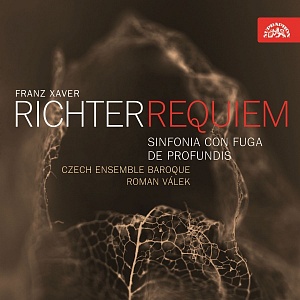
CZECH ENSEMBLE BAROQUE DISCOVER F. X. RICHTER'S MUSIC
The founder and chief conductor of Czech Ensemble Baroque, Roman Válek, talks to us about their new album


The new CD you have recorded for Supraphon features music by a single composer, Franz Xaver Richter. Can you tell us more about him?
F. X. Richter is one of those composers we can refer to as both known and unknown. In the past, it was customary, and actually resulted in making Czech music famous, for Czech composers to work in Europe’s major music centres, such as Rome, Milan, Berlin and Vienna. If they wanted to gain success and renown, they had to win recognition abroad. And, as a matter of fact, we can say that it still holds true for contemporary artists too.
This was also the case of Richter, a Moravian native, who was employed by Ignaz Holzbauer at his court orchestra in Holešov. After some time, to further hone his musical skills he moved to Vienna, where he was primarily inspired by J. J. Fux’s work. His next stop was Germany, first working at the Stuttgart court orchestra, then at the monasteries in Schlitz and Ettal, where he gained ample experience with church music. The best-known tenure, though not the most significant for Richter, was his 22 years in Mannheim, where he composed the majority of his symphonic works. His final, long-term, and evidently dreamt-of, place of work was Strasbourg, where he served as Kapellmeister at the Cathédrale Notre-Dame, which at the time was one of the greatest in Europe and possessed the third-largest music ensemble in France.
In addition to symphonic works, Richter also composed numerous sacred pieces. Although this may be surprising for some musicologists, when you take a look at Richter’s oeuvre pragmatically, you realise that the church environment influenced him throughout his life and that the quantity of the sacred pieces he wrote is higher than the dozens of his generally known, superlative symphonies.
The album contains pieces that can be labelled as “mourning”. What made you include them?
In part, we took into consideration the situation on the market. I must point out, and it is paradoxical for Czech musicians, that the greatest and most noted performer of F. X. Richter’s works is a Finnish ensemble, the Helsinki Baroque Orchestra, who have made a high-quality recording of his symphonies. Hence, we chose to focus on Richter’s sacred music, with our aim being for the selected works to also have an interesting history. And his Requiem in E flat major is a case in point. It contains certain Romantic traits, similar to Mozart’s work. Richter basically wrote this piece for himself and considered it to be of great importance. The composition is endowed with a Romantic tinge by the fact that the maestro allegedly died while putting the finishing touches to his Requiem…
I would like to emphasise that at first listen the work may not come across as attractive, with the reason being that it is funeral music, that it is not intended for being performed in one go, and Richter himself might not have imagined that the Requiem would ever be played at a concert. But we can say the same about, for instance, Mozart’s Requiem or other works dating from the pre-Romantic era.
When it comes to the instrumental music featured on the album, I would like to add that I sought a piece that can be classified as one of Richter’s church sinfonias. This symphony contains a great fugue, one corresponding to Handel’s or Bach’s style. I deemed it crucial to find a symphony that would also relate to the Requiem tonally, which in this case are the keys E flat major/G minor. In Richter’s time, E flat major was a key expressing cogency, melancholy even.
Is Richter’s music anywise exceptional in comparison with that of his contemporaries?
It is interesting that the ensembles devoting to historically informed performance pay little attention to the transitional period between late Baroque and early Classicism, specifically the end of the 18th century, when composers pursued two different paths. Composers like C. P. E. Bach strove to enrich late Baroque with new types of embellishments, more complex rhetorical figures and other elements. Another group of composers took a new route, trying to simplify everything. I would say that Richter belongs in the first camp. He sought to attain a synthesis of the Baroque style, polyphony in particular, for which he was often criticised by younger composers of the time. The most castigated were his fugues. And the Requiem contains no fewer than eight of them, which makes the performance challenging indeed.
You new CD was recorded in Znojmo. What made you chose this town in particular?
We have been the ensemble in residence of the summer festival in Znojmo for 12 years, performing operas and sacred music. I became really fond of the local Saint Michael Church several years ago, when I was recording Lully’s Te Deum for Czech Radio. I like being able to record sacred music in sacred venues.
Can we expect to hear you performing Richter’s funeral music live at your concerts?
We gave the majority of concert performances of Richter’s Requiem prior to making the recording, so as to digest the work properly. My aim is to play the piece at the Strasbourg Cathedral, for which Richter wrote his Requiem. I believe that our recording will result in Richter’s name becoming more familiar among concert organisers in such countries as France and Germany too.